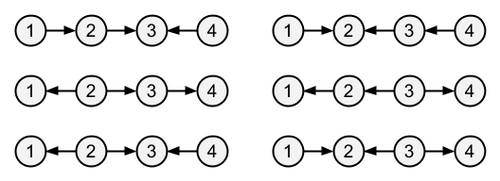Score : 1800 points
Problem Statement
There is a tree T with N vertices, numbered 1 through N. For each 1 ≤ i ≤ N - 1, the i-th edge connects vertices a_i and b_i.
Snuke is constructing a directed graph T' by arbitrarily assigning direction to each edge in T. (There are 2^{N - 1} different ways to construct T'.)
For a fixed T', we will define d(s,\ t) for each 1 ≤ s,\ t ≤ N, as follows:
- d(s,\ t) = (The number of edges that must be traversed against the assigned direction when traveling from vertex s to vertex t)
In particular, d(s,\ s) = 0 for each 1 ≤ s ≤ N. Also note that, in general, d(s,\ t) ≠ d(t,\ s).
We will further define D as the following:

Snuke is constructing T' so that D will be the minimum possible value. How many different ways are there to construct T' so that D will be the minimum possible value, modulo 10^9 + 7?
Constraints
- 2 ≤ N ≤ 1000
- 1 ≤ a_i,\ b_i ≤ N
- The given graph is a tree.
Input
The input is given from Standard Input in the following format:
N
a_1 b_1
a_2 b_2
:
a_{N - 1} b_{N - 1}
Output
Print the number of the different ways to construct T' so that D will be the minimum possible value, modulo 10^9 + 7.
Sample Input 1
4 1 2 1 3 1 4
Sample Output 1
2
The minimum possible value for D is 1. There are two ways to construct T' to achieve this value, as shown in the following figure:

Sample Input 2
4 1 2 2 3 3 4
Sample Output 2
6
The minimum possible value for D is 2. There are six ways to construct T' to achieve this value, as shown in the following figure:

Sample Input 3
6 1 2 1 3 1 4 2 5 2 6
Sample Output 3
14
Sample Input 4
10 2 4 2 5 8 3 10 7 1 6 2 8 9 5 8 6 10 6
Sample Output 4
102